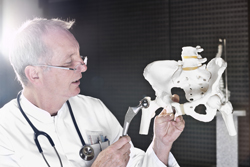Joint replacement procedures are initial focus
 Hip and knee replacements are the most common inpatient surgery for Medicare beneficiaries and can require lengthy recovery and rehabilitation periods, according to the Centers for Medicare & Medicaid Services. In 2014, there were more than 400,000 procedures, costing more than $7 billion for the hospitalizations alone. Despite the high volume of these surgeries, quality and costs of care for hip and knee replacement still vary greatly among providers.
Hip and knee replacements are the most common inpatient surgery for Medicare beneficiaries and can require lengthy recovery and rehabilitation periods, according to the Centers for Medicare & Medicaid Services. In 2014, there were more than 400,000 procedures, costing more than $7 billion for the hospitalizations alone. Despite the high volume of these surgeries, quality and costs of care for hip and knee replacement still vary greatly among providers.
That’s one reason why CMS is eager to begin a bundled-payment program for hip and knee replacements. And that also explains why the American Society of Anesthesiologists and Premier Inc. have focused on joint replacements in their Learning Collaborative on the Perioperative Surgical Home – a patient-centered, team-based practice model of coordinated care that guides patients through the entire surgical experience, from the decision to undergo surgery to discharge and beyond.
On April 1, 2016, CMS was scheduled to launch the Comprehensive Care for Joint Replacement (CJR) model, in order to test bundled payment and quality measurement for an episode of care associated with hip and knee replacement. The purpose is to encourage hospitals, physicians, and post-acute care providers to work together to improve the quality and coordination of care from the initial hospitalization through recovery.
CMS hopes the alternative payment model will contribute to the Medicare goals set by the Obama administration of having 30 percent of all Medicare fee-for-service payments made via alternative payment models by 2016, and 50 percent by 2018.
The CJR model will hold participant hospitals financially accountable for the quality and cost of a CJR episode of care, and will incentivize increased coordination of care among hospitals, physicians, and post-acute care providers. The episode of care begins with an admission to a participant hospital of a beneficiary who is ultimately discharged under MS-DRG 469 (Major joint replacement or reattachment of lower extremity with major complications or comorbidities) or 470 (Major joint replacement or reattachment of lower extremity without major complications or comorbidities), and ends 90 days post-discharge in order to cover the complete period of recovery for beneficiaries.
The episode includes all related items and services paid under Medicare Part A and Part B for all Medicare fee-for-service beneficiaries, with the exception of certain exclusions.
Editor’s note: For more information on the American Society of Anesthesiologists Perioperative Surgical Home, go to https://www.asahq.org/psh
